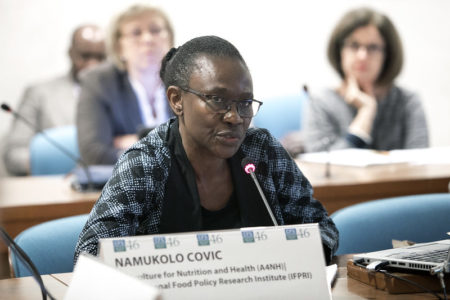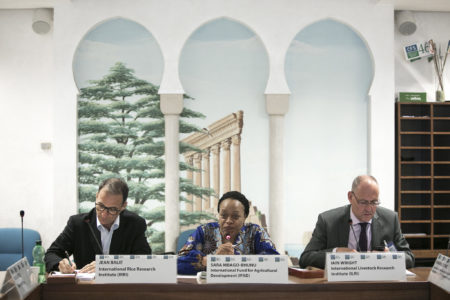An unbalanced plate threatens not only human nutrition and related poor health outcomes, but also the planet. However, what does it take to create a healthy plate—for the developing world—based on sustainable food systems? Agricultural and nutrition scientists from the CGIAR sought to answer this question during a side event held at the Committee on World Food Security (CFS46) in Rome, Italy. Delegates from 126 countries, key UN organizations and over 200 private sector and civil society representatives had gathered at CFS, 14 – 18 October, to review the 2019 State of Food Security and Nutrition in the World report (SOFI 2019) and the Voluntary Guidelines on Nutrition.
“It’s very clear that current food production and consumption practices are not very conducive to the type of sustainability that we require or desirable nutrition and health outcomes and that some actions are needed” said Namukolo Covic, Research Coordinator from the CGIAR Research Program on Agriculture for Nutrition and Health (A4NH) led by the International Food Policy Research Institute (IFPRI) during her keynote address.

With the publication of these seminal reports, it’s important to consider how recommendations would fit into food systems in the Global South.
“Equal treatment is not what is always needed. But lessons should be learned to chart a more positive direction in Africa and Asia, avoiding mistakes that have already been made elsewhere”, said Covic.
Agricultural research for food system transformation
With nearly 50 years of in-depth research on sustainable food systems, the CGIAR has amassed lessons that could help inform the CFS on sustainable food systems and nutrition. The guidelines are expected to counter the existing policy fragmentation between the food, agriculture and health sectors, address livelihood and sustainability challenges, help make food systems nutrition-sensitive, and promote secure access to safe, diverse and high-quality diets for everyone.
Both the SOFI 2019 and State of the World’s Children reports underline that progress in addressing malnutrition has been too slow to achieve the 2025 Global Health Assembly and 2030 Sustainable Development Goals (SDG 2) targets. In fact, the number of hungry people has increased over the last three years and with this an urgent need to sustainably scale up production of nutritious foods.

Improved crop varieties and livestock production systems
One successful technology proven to be cost-effective and efficacious for improving diet quality is biofortification. This entails the use of conventional plant breeding methods to develop improved varieties of major staple crops, enriched with micronutrients: vitamin A, iron and zinc, frequently absent from diets in low- and middle-income countries (LMICs). Biofortified crops released to date include vitamin A cassava, maize and orange-fleshed sweetpotato (OFSP); iron beans and pearl millet; and zinc rice and wheat.
“These varieties are delivered strategically in countries and areas where staple crops are produced and consumed in large quantities and where micronutrient-dense foods are not easily accessible”, said Ekin Birol, Director of Impact and Strategy at HarvestPlus.
By the end of 2018, over 340 varieties of 12 biofortified staple crops had been released in over 40 LMICs. At least 40 million people across 15 countries had benefited from biofortified foods. Moreover, 21 countries had included biofortification in their agriculture or nutrition policies.
The factors that contributed to this success include investment in research for development and nutrition evidence; partnerships with key stakeholders including national agricultural research systems (NARS) and women and men farmers; as well minimum behaviour change needs in adoption of biofortified varieties.
‘#Biofortification may not be a silver bullet for tackling all malnutrition problems but it is a golden opportunity for improving micronutrient intake through key staples consumed daily’@ekinbirollopez @HarvestPlus #cfs46 #cgiaratcfs46 #zerohunger #ruralwomen @irri @A4NH_CGIAR pic.twitter.com/myKew25CgS
— CIP – Potato Center (@Cipotato) October 15, 2019
ILRI’s Iain Wright addressed the critical role that animal-source foods played in the diets of people living in developing countries. Referencing calls by the EAT Lancet report to reduce the consumption of animal source foods in the developed world, he noted such calls sometimes disregarded the need to increase consumption in the developing world.
Meat, milk, eggs and fish provide micronutrients and are therefore critical to healthy diets and are a source of livelihoods in many communities.
“Given their increasing importance, significant opportunities exist to intensify the smallholder agriculture sector to meet increasing demand. Africa’s rural population will continue to grow and with it so will smallholder farming, mostly mixed crop and livestock” said Wright, ILRI’s Deputy Director General for Research and Development.

On the contribution of root and tuber crops (RTCs), Ian Barker from CIP noted they were naturally nutritious and hence could contribute towards good diets. These crops—potato and sweetpotato—have a short growing cycle and therefore play an important role in addressing the hunger gap for household food security.
In many households, RTCs and bananas are both cash and food crops. For potato, 70 percent of the harvest is sold for cash.
“If we are raising productivity, we are also raising incomes. In Kenya and Ethiopia, extra money means farmers can pay school fees for their children, build better houses and invest in livestock” noted Barker, who leads CIP’s Potato Agri-Food Systems program.
Adoption of a multi stakeholder approach, as has been the case disseminating OFSP, ensures quick gains and more success. CIP and partners have reached at least 6 million vulnerable households in Africa and Asia with nutritious sweetpotato.
The policy factor in attaining healthier diets
IRRI’s Agri-food Policy Platform Leader, Jean Balié, further enriched the discussions by offering insights on policy. Current food policies have focused on producing abundant and cheap food with a focus on availability to the detriment of other dimensions of food security such as utilization (quality) or access (equity). Policies should focus on better food for all and everywhere. This means a shift from a focus on agricultural policy (producer centered) to food policy (consumer centered).
Did you know, worldwide, we rely on only 14 major crops? At #cfs46 @CGIAR event @irri Jean Balie called for ‘a paradigm shift from producing abundant cheap food to diversified nutritious food. Policy incentives could help shift the focus’ #cfs46 @cgiaratcfs46 #ruralwomen pic.twitter.com/mJiMo1NXXw
— CIP – Potato Center (@Cipotato) October 15, 2019
Market forces can help promote healthy, sustainable diets. A growing number of consumers are willing to pay more for sustainably produced, nutritious food. However, this is not the case across the income spectrum.
“Estimates show USD 650 billion is spent every year on food subsidies. This has led to overuse of fertilizers, pesticides and water which are detrimental to the environment.” said Balié.
Policies must ensure the true cost of food production is captured. “While this may lead to higher consumer prices, it will also mean higher farmer prices. Consequently, small marginalized farmers in the Global South will have an opportunity to compete on a more level playing field. Some of these subsidies should be diverted towards helping poor consumers gain access to more expensive food”, he added.
Inevitable trade-offs between several policy objectives exist: supply more food to feed a growing population, increase prosperity (incomes) in rural areas, achieve food production and consumption sustainability, and deliver nutritious and safe foods. This calls for support to governments to elicit and articulate the trade-offs along the food transformation pathway as one strategic approach toward achieving zero hunger.
With less than ideal consumer food choices ready to frustrate attempts towards healthy diets, a paradigm shift is needed at policy level and on a global scale to ensure we make progress soon. “Better consumer information and nutritional literacy would take us a long way to increasing demand for healthy and sustainable food choices” said Balié.
Overall, these perspectives from CGIAR scientists—informed by ongoing work—could go a long way in ensuring healthier diets for the Global South, much sooner. With climate change threatening livelihoods and food security, the interface between the environment and healthy diets cannot be ignored and must be addressed for the long-term sustainability of food security.
“Today’s discussion has helped us hone in on some of the real costs and opportunities in promoting healthier and sustainable diets in the south. Let us continue the conversation”, concluded Mbago-Bhunu.
All photos from the event are available on Flickr.
Blog written by Vivian Atakos. Contributions were received from Namukolo Covic, Ekin Birol, Jean Balié, Temina Lalani-Shariff, KC Santos, Janet Hodur, Peter Goldstein and James Stapleton.
